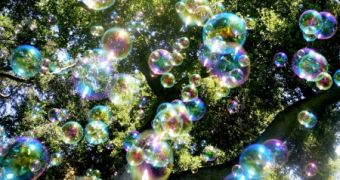As many media and environmental agencies have already pointed out countless times, climate change leads to quite violent weather manifestations.
Unless we find ways to better understand such phenomena, it might be just a matter of time before our daily routines are literally blown into the four winds.
A new experiment conducted at the University of Bordeaux showed that by heating up soap bubbles, one can come up with a beautifully-colored laboratory-made hurricane.
This tempest wanna-be can then be used to design a mathematical model that can predict the trajectory of certain kinds of storms.
According to OurAmazingPlanet, professor Hamid Kellay, one of the researchers involved in this study, explained that their soap vortices behaved as hurricane-like as possible: “It's like a drunken man's walk. It will go from point A to point B, while still following a main path.”
Thus, based on the soap bubble's initial movements, the team successfully predicted what its final destination would be.
Apparently, similar calculations can be used when dealing with proper tornadoes, as the working principles are roughly the same.
Naturally, “professional” scientists were not all that much impressed with this experiment, but they did qualify it as being somewhat interesting.
One of them, Jonathan Vigh, from the National Center for Atmospheric Research, said that: “It is certainly novel that the authors have compared the vortices in a soap bubble to a hurricane — they are both vortices.”
Their main argument against the soap-tempests is that the mathematical model developed by the researchers at the University of Bordeaux is likely to be unreliable, as real tornadoes and other kinds of storms can only occur out in the open, and not is some laboratory with restricted access.
This makes them vulnerable to various external influences, so in the end they might end up raging havoc in regions nobody thought they would ever make it to.

 14 DAY TRIAL //
14 DAY TRIAL //